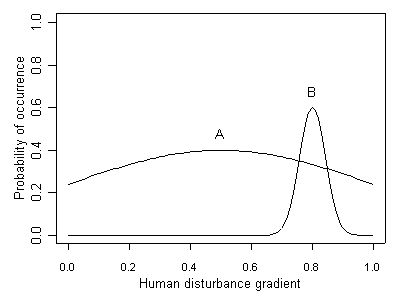PECBO Appendix Introduction: Definitions
Definitions
The use of the term tolerance in biological assessments differs from the use of the term in ecology. The ecological definition of tolerance refers to the niche breadth, or the range of conditions that an organism can withstand. Based on this definition, more tolerant organisms can withstand a broader range of conditions. To quantify niche breadth, we would measure the range of conditions over which a particular taxon can persist.
In biological assessment, the term tolerance generally is used with respect to a gradient of human disturbance (Hilsenhoff 1987). That is, a tolerant organism is one that is likely to be found in a highly altered or degraded site. Many species would be considered tolerant based on either definition. For example, species A in Figure 3 likely would be observed at a degraded site, and therefore would be considered tolerant in terms of biological assessment. However, species A also is found in conditions that span the entire observed gradient, and so it is ecologically tolerant. Some species thrive in degraded sites, yet have a narrow niche breadth. These species are therefore tolerant in the context of biological assessment even though they are not tolerant in the ecological sense (species B in Figure 3). In this modulequick, the term tolerance is used strictly in terms of biological assessment.

References
- Hilsenhoff WL (1987) An improved biotic index of organic stream pollution. Great Lakes Entomologist 20:31-39.
